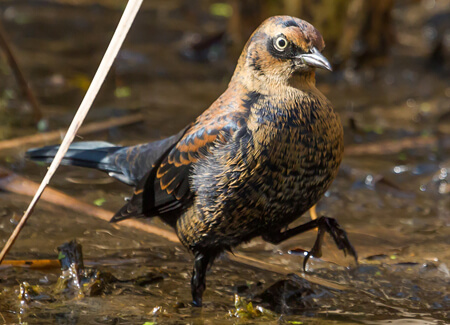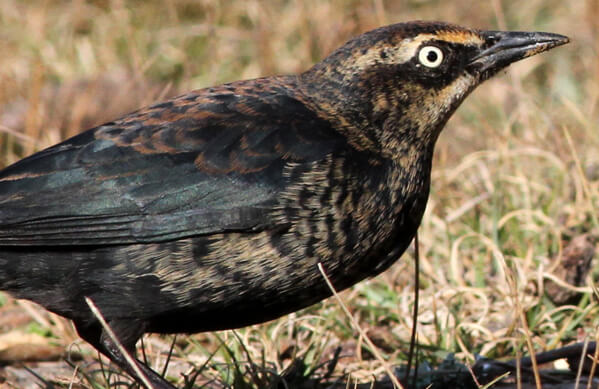 In 40 years, the once-common Rusty Blackbird lost between 85 and 95 percent of its population, making it one of the fastest declining North American landbirds. The only North American blackbird more troubled is the Tricolored Blackbird, a localized and declining bird of West Coast wetlands.
In 40 years, the once-common Rusty Blackbird lost between 85 and 95 percent of its population, making it one of the fastest declining North American landbirds. The only North American blackbird more troubled is the Tricolored Blackbird, a localized and declining bird of West Coast wetlands.
The Rusty Blackbird's tailspin leaves conservationists scratching their heads. Why the steep decline in this boreal songbird? Read on to learn the suspected causes.
Bye, Bye Blackbird
At first blush, the Rusty Blackbird's growing scarcity makes no sense. After all, much of the bird's breeding range in the boreal forest is remote and roadless, so human impact seems a less likely factor than in areas with cities and suburbs.
For now, scientists strongly suspect a few factors at play in the bird's decline:
- Climate change, which may cause wetlands to dry up more frequently, and also may throw off peak times for aquatic and other insects, affecting blackbird breeding.
- Destruction of wetlands for agriculture in the United States wintering range, combined with degradation of remaining habitat.
- A combination of these and other threats, including the poisoning of blackbird flocks and infiltration of Red-winged Blackbirds and Common Grackles into degraded habitats, where these birds likely compete with Rusty Blackbirds.
(Audio: Rusty Blackbird song recorded in Pedricktown, NJ, by Paul Driver, XC172834. Accessible at www.xeno-canto.org/172834. )
Rusty Blackbirds belong to the family Icteridae, which includes other blackbirds, cowbirds, grackles, bobolinks, orioles, and meadowlarks. Other blackbirds remain common, but are not immune to trouble.
In many agricultural areas, blackbird flocks are poisoned. Such measures threaten not only scarce blackbirds like the Rusty — they hit at common species now known to be in decline. The familiar backyard Common Grackle, for example, was just uplisted on the IUCN Red List to Near Threatened due to widespread declines.
Within their habitats, blackbirds provide important services, consuming many insects, for example. After breeding, though, large roaming flocks frequent farms. Sometimes they damage crops; other times they eat waste grain left over from the harvest.
A Bird Drawn to Water
At all times of year, watch for the Rusty Blackbird at the water's edge, particularly in wetlands with standing trees and plenty of rich muck. On the northern breeding grounds, these habitats include bogs, beaver ponds, and meandering waterways — wet habitats punctuating the boreal forest, which is also home to the Olive-sided Flycatcher, Bay-breasted and Cape May Warblers, Canada Jay, and many other nesting species.
When searching for food, Rusty Blackbirds walk the water's edge or wade in, sometimes plunging their heads underwater to snatch a particularly prized food item, be it a dragonfly, caddisfly, or mayfly larva or another aquatic insect, or sometimes even a small fish, crayfish, or salamander. Also on the diet: grasshoppers and other terrestrial insects, snails, and, reported a time or two, a weakened, dying songbird. Particularly in colder months, this blackbird's diet switches to seeds and some small fruits.
Nesting North, Wintering South
Most Rusty Blackbirds nest in Canada and Alaska. Only a small sliver of the breeding range reaches northern New England, upstate New York, and far-northern Michigan and Minnesota. In winter, however, this bird is only found in the eastern United States, especially in the Southeast.
Rusty Blackbirds usually travel and feed in small to medium-sized flocks, sometimes loosely associated with other blackbirds. A lone bird turns up every now and then. Large areas of undisturbed floodplain forest, such as those found in Arkansas' Big Woods region, are particularly important wintering grounds.

Rusty Blackbird by Paul Roedding, Shutterstock
Polishing Rusty Blackbird ID Skills
With its understated field marks and vocalizations — and increasing scarcity — the Rusty Blackbird often eludes birders.
Nonbreeding or “fall” Rusty Blackbirds are easiest to identify because they sport rust-tinged body and wing feathers, plus broad, dark masks punctuated by their piercing yellow eyes. In this plumage, the female is most striking, with straw-colored buff on her head and breast. The male is darker but still has rust feathers on wings and head.
In breeding plumage, the male is more colorful than the female, donning glossy purplish plumage that recalls the Common Grackle, except that the Rusty Blackbird's tail is shorter and rounded, not graduated, and its bill is shorter and thinner. The breeding female Rusty Blackbird is flat brown overall with subtle barring and, of course, those yellow eyes.
Away from the East Coast, the Rusty Blackbird's range overlaps with that of the closely related and very similar Brewer's Blackbird. The Brewer's Blackbird is far more likely to be seen away from water and near people — on lawns, in parking lots, on farms and feed lots, and in neighborhood parks. Sometimes, though, these species occur in the same areas, and visual identification can be a challenge.
The Brewer's Blackbird has basically the same size and shape as the Rusty Blackbird, except:
- In breeding plumage, male Brewer's Blackbirds are much glossier purple. In nonbreeding plumage, most male Brewer's Blackbirds remain somewhat glossy, although some recall Rusty Blackbirds, but lack any rust in the wings.
- Female Brewer's Blackbirds have a brown-gray coloration similar to that of female Rusty Blackbirds, but they almost always have dark eyes.
Boreal Treatments
Rusty Blackbirds weave the trappings of their wetland habitat into their nest décor. Under thick cover, the female chooses a bush or small conifer, where — often just a few feet above the water or ground — she builds a cup nest woven of sticks and perhaps tough grasses. Inside, she dabs on a slimy lining of decaying vegetation, then tops this middle layer with a carpet of fine grasses.
For two weeks, the female incubates four or five eggs, which are blue, dappled with brown or gray. After the young hatch, they are fed by both parents for 12 days or so before fledging.
Sign up for ABC's eNews to learn how you can help protect birds
A Look Ahead
The International Rusty Blackbird Working Group, ABC, and other conservation organizations, government agencies, along with an army of volunteer birders, are keeping an eye on Rusty Blackbirds and their habitats. As more details come to light on the species' distribution and life history, we hope to find ways to secure a better future of this wet-footed blackbird.
You can play a role in helping this bird by reporting your Rusty Blackbird sightings to eBird.org and other citizen science bird monitoring websites.
Help ABC Reverse Bird Declines
ABC works to reverse declining bird populations — and with your help, we can bring birds back, protect their habitats, and tackle the toughest threats.
Please help us raise $1 million for birds by December 31, 2018 so we can write a better story for the Rusty Blackbird and other declining birds!
Donate to ABC to change the story for birds!



















































